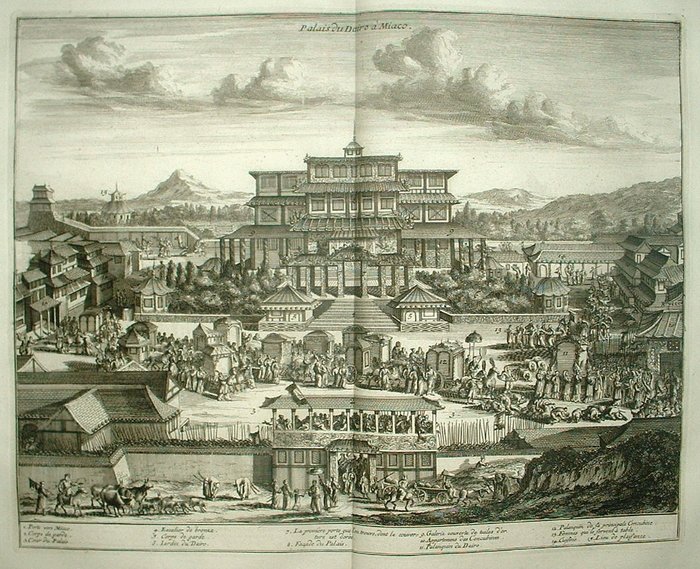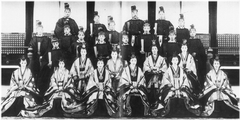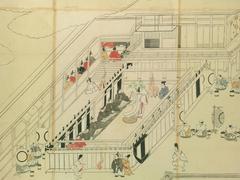
Kyoto Imperial Palace Visiting Hours, Tickets, and Travel Guide
Date: 14/06/2025
Introduction: History and Cultural Significance
The Kyoto Imperial Palace, nestled in Kamigyo-ku at Kyoto’s heart, is a monument to Japan’s imperial heritage and a window into the country’s cultural and architectural evolution. For over 1,000 years, beginning with Emperor Kanmu’s establishment of Heian-kyō in 794 CE, it served as the seat of the Japanese emperors and the nucleus of court culture during the Heian period—a golden age for Japanese arts and literature (Imperial Household Agency).
The palace’s legacy persisted even after Japan’s capital was moved to Tokyo in 1869, maintaining its place as a site for major imperial ceremonies and a symbol of continuity. Its architecture combines the stately shinden-zukuri style of the Heian era with influences from later periods, particularly the Edo period, reflected in iconic structures such as the Shishinden (Hall for State Ceremonies) and Seiryōden (Emperor’s Residence) (Japan Experience; SakuraTrips).
Today, the Kyoto Imperial Palace welcomes visitors free of charge, offering daily guided tours and beautifully maintained gardens that are especially captivating during cherry blossom and autumn foliage seasons. This guide provides detailed information on visiting hours, tickets, accessibility, architectural highlights, travel advice, and nearby attractions to help you experience one of Japan’s most significant historical sites.
Table of Contents
- Introduction: History and Cultural Significance
- Historical Overview
- Main Attractions and Architectural Highlights
- Visiting Information
- Travel Tips and Nearby Attractions
- Frequently Asked Questions (FAQ)
- Conclusion
- References
Historical Overview
Origins and Early History
The Kyoto Imperial Palace’s origins trace back to 794 CE, when Emperor Kanmu moved the capital to Heian-kyō, marking the beginning of the Heian period. The palace became the seat of the imperial family by 1331 and remained central to Japanese court life for centuries (Imperial Household Agency). Throughout its history, the palace complex underwent several reconstructions due to fires, with the current iteration dating largely to an 1855 restoration.
Architectural Evolution
The palace complex is enclosed by traditional earthen walls and organized along a north-south axis influenced by ancient geomancy. Its architecture exemplifies the shinden-zukuri style, noted for open verandas, raised wooden floors, and cypress bark roofs. Later additions reflect Edo-period tastes and practicalities, creating a harmonious blend of historical influences. Interiors are adorned with painted fusuma (sliding doors) and screens depicting courtly and seasonal themes.
Role in Japanese History
During the Heian period, the palace was the center of Japan’s political, spiritual, and cultural life, witnessing the creation of literary classics such as The Tale of Genji. Even after the shogunate’s rise, the palace retained ceremonial importance. Its legacy continues today through imperial rituals and festivals, symbolizing Japan’s enduring dynastic traditions.
Main Attractions and Architectural Highlights
Shōmeimon Gate
Serving as the principal entrance, Shōmeimon is a striking example of imperial architecture, featuring a gracefully curved roof, intricate woodwork, and decorative metalwork. The gate historically marked the boundary between the imperial court and the outer world (SakuraTrips).
Visual suggestion: Photo of Shōmeimon Gate with alt text “Kyoto Imperial Palace Shōmeimon Gate showcasing traditional Japanese architecture.”
Shishinden (Hall for State Ceremonies)
The ceremonial heart of the palace, Shishinden, is built in the shinden-zukuri style and was the site of enthronements and other major imperial rites. The hall’s sweeping roof and open design embody imperial dignity and authority (SakuraTrips; Besides the Obvious).
Seiryōden (Emperor’s Residence)
Once the emperor’s living quarters, the Seiryōden reflects the refined residential architecture of the Heian and Edo periods. While interior access is restricted, the exterior’s sliding fusuma doors and tranquil garden settings can be admired by visitors (SakuraTrips).
Oikeniwa Garden
Oikeniwa Garden is designed for contemplative strolls, with a central pond, stone bridges, and seasonal plantings. It exemplifies the Japanese landscape principle of “borrowed scenery” (shakkei), integrating distant views and palace architecture (SakuraTrips; Japan Manifest).
Additional Features
- Kogosho (Minor Palace Hall): Used for smaller ceremonies, showcasing Shoin-zukuri style.
- Gonaitei (Inner Palace Garden): A private garden accessible during special tours.
- Corridors and Verandas: Covered walkways provide scenic perspectives of the grounds.
Visiting Information
Visiting Hours and Tickets
- Hours: 9:00 AM – 5:00 PM (last entry at 4:30 PM). Closed on Mondays (or the next day if Monday is a holiday) and from December 28 to January 4.
- Admission: Free of charge. Advance reservation is recommended via the Imperial Household Agency website. On-site passes may be available.
- Seasonal Adjustments: Hours may change for special events or maintenance; always check the official website before your visit (Agoda Guide).
Accessibility
The palace grounds are largely flat and wheelchair accessible, with paved paths and accessible restrooms. Some historical structures may have limited access due to preservation measures (Inside Kyoto).
Guided Tours and Events
- Guided Tours: Free tours in English are offered daily at 10:00 AM and 2:00 PM, lasting about 50–60 minutes. Arrive early at the Visitor’s Room to join (Agoda Guide).
- Special Events: The palace hosts imperial ceremonies and festivals such as the Aoi Matsuri each May 15th, beginning at the palace and proceeding to the Kamo shrines (JW Web Magazine).
Photography Guidelines
Photography is permitted in outdoor areas but restricted inside the buildings. Tripods and drones are not allowed to ensure the tranquillity and preservation of the site.
Seasonal Highlights
The palace grounds are particularly beautiful during cherry blossom season (late March–early April) and autumn foliage (November). Early morning visits on weekdays offer a more peaceful experience.
Getting There
- Location: Kyoto Gyoen 3, Kamigyo-ku, Kyoto, within Kyoto Gyoen National Garden.
- Access: Subway (Karasuma Line to Imadegawa Station), approximately a 10-minute walk. Multiple city buses also serve the area.
Travel Tips and Nearby Attractions
- Combine your visit with the Sento Imperial Palace (by guided tour), Nijo Castle, and the Kyoto National Museum for a broader historical perspective (Visit Japan Vegetarian).
- Wear comfortable shoes; the palace grounds are extensive.
- Facilities: No food vendors inside the palace; vending machines and picnic areas are in the surrounding park.
- Virtual resources: Explore official virtual tours and interactive maps to plan your route efficiently.
Frequently Asked Questions (FAQ)
Q: What are the Kyoto Imperial Palace visiting hours?
A: 9:00 AM to 5:00 PM, last entry at 4:30 PM. Closed Mondays and during the New Year period.
Q: Is admission free?
A: Yes, entry is free. Advance reservation is recommended for tours.
Q: Are guided tours available in English?
A: Yes, free English-language tours are offered daily at 10:00 AM and 2:00 PM.
Q: Is the palace wheelchair accessible?
A: Yes, the grounds are accessible, though some gravel paths may be challenging.
Q: Can I photograph the palace?
A: Photography is allowed outdoors but not inside the buildings.
Q: Are there nearby attractions?
A: Yes—Sento Imperial Palace, Nijo Castle, and various shrines and museums.
Conclusion
The Kyoto Imperial Palace stands as a living testament to Japan’s imperial history, courtly aesthetics, and cultural traditions. With free admission, accessible grounds, and enriching guided tours, it is a must-see for anyone interested in Kyoto’s historical sites. Plan your visit during cherry blossom or autumn foliage seasons, secure reservations, and explore adjacent attractions for a complete cultural experience. For the latest updates and comprehensive guides, download the Audiala app and follow our social channels.
References
- Kyoto Imperial Palace: Visiting Hours, Tickets, History, and Travel Tips (Imperial Household Agency)
- Kyoto Imperial Palace: Visiting Hours, Tickets, and Cultural Highlights in Kyoto (Japan Experience)
- Kyoto Imperial Palace Visiting Hours, Tickets, and Top Attractions in Kyoto (SakuraTrips)
- Kyoto Imperial Palace Visiting Hours, Tickets & Guide to Kyoto Historical Sites (Agoda Guide)
- Kyoto Imperial Palace: Architectural and Cultural Significance (JW Web Magazine)
- Kyoto Imperial Palace Preservation and Cultural Continuity (Bespes JT)
- Kyoto Imperial Palace Gardens and Spirituality (Japan Manifest)
- Kyoto Sento Imperial Palace and Nearby Attractions (Visit Japan Vegetarian)
- Kyoto Imperial Palace: Central Kyoto (Inside Kyoto)
- Imperial Palace Kyoto: A Majestic Journey (Besides the Obvious)












































































